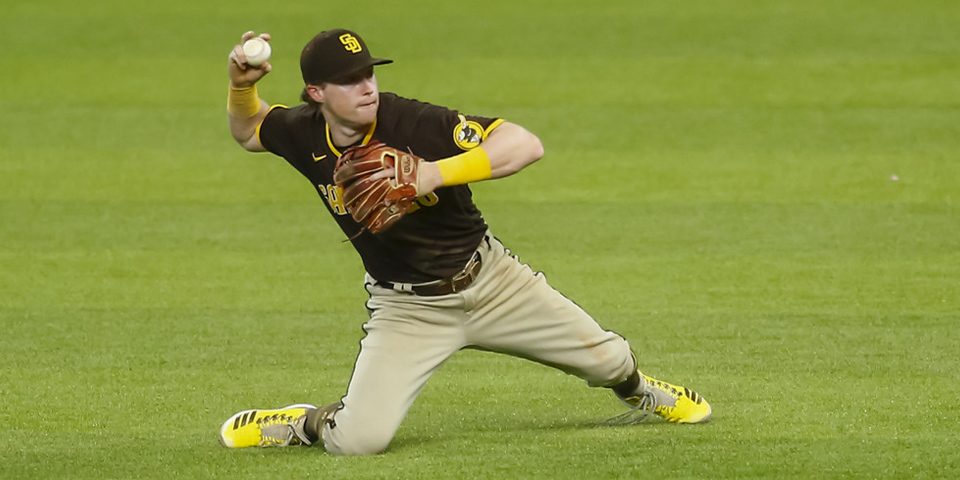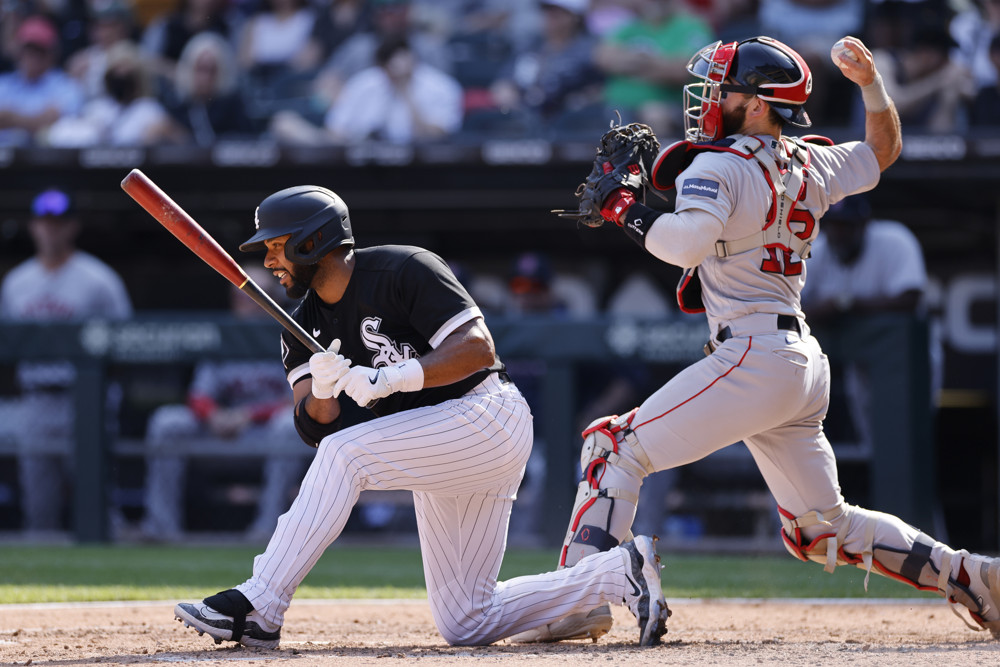BY ALEX VIGDERMAN
This is a less fun update than what we did during the 2019-20 offseason, in which we were announcing a revamp of how we evaluate defense, but one that is no less crucial.
The lifeblood of our work at SIS is recording data points from video. Defensive Runs Saved in particular relies on elements like the direction, timing, and trajectory of batted balls. As it turns out, since 2017 MLB games have more and more commonly had a disconnect between the actual timing of a play and what shows on the broadcast. Specifically, when the camera switches away from the center field camera to show the batted ball on balls to the infield, the play appears to take less time than it does in reality. This means that in timing any event on that play from video, the resulting measurement will be a couple hundred milliseconds short on average.
You can see where this might be a problem for defensive metrics. A ball gets hit at a certain speed, but when recording the time over video it seems like the ball is traveling faster than it is. That means that we’ll end up giving the fielder more credit than he deserves for making that play (or less blame if he fails to make it).
This isn’t a problem going forward—we’re now able to use a camera angle that will give us the full view of the play from the start—but for recent seasons, we had to resort to an automated method to fix affected balls in play. Going back to 2017, SIS’s ball-in-play times have been retroactively modified using an automated process, one that checks each park each month for the existence of a 100-ms-or-greater offset, and modifies all relevant batted balls to account for that offset. This phenomenon didn’t start until a few years ago, so it affects only a couple parks in 2017, but that number jumped to more than half of parks in 2018 and 2019. In 2020, we had access to the new camera angle, but because Defensive Runs Saved uses multiple years of data as the basis for its evaluation, those numbers do change slightly.
When and where will I see these changes?
The updated numbers are currently available on FieldingBible.com. Because there are so many other sites with different preseason work of their own to take care of, we couldn’t make it so that we had a single point in time when all sources of Defensive Runs Saved update in tandem. So what you find on Fangraphs, Baseball-Reference, etc. won’t match with what you find on the Fielding Bible site for a bit. But we’ll be aligned by the start of the MLB season.
It’s worth noting that this will also affect metrics that depend on our ball-in-play times, like Hard Hit Rate and Ultimate Zone Rating. As mentioned, we’re working with Fangraphs to get their numbers backfilled, but because of the mechanics of it we can’t update them without updating ourselves first.
Which teams were affected by this?
As mentioned above, this asynchrony has crept to more and more parks over time. These are the parks that had at least one month where times in that park were offset, by season (excluding 2020 because the offset has been compensated for by the use of the new camera angle).
| 2017 | 2018 | 2019 |
| Comerica Park | Angel Stadium of Anaheim | Angel Stadium of Anaheim |
| Tropicana Field | AT&T Park | AT&T Park |
| Busch Stadium | Busch Stadium | |
| Chase Field | Chase Field | |
| Comerica Park | Citizens Bank Park | |
| Dodger Stadium | Comerica Park | |
| Great American Ballpark | Dodger Stadium | |
| Kauffman Stadium | Great American Ballpark | |
| Marlins Park | Kauffman Stadium | |
| Miller Park | Marlins Park | |
| O.co Coliseum | Miller Park | |
| PETCO Park | Minute Maid Park | |
| Progressive Field | O.co Coliseum | |
| Rangers Ballpark in Arlington | PETCO Park | |
| SunTrust Park | Progressive Field | |
| Target Field | Rangers Ballpark in Arlington | |
| Tropicana Field | SunTrust Park | |
| Yankee Stadium | Target Field | |
| Tropicana Field | ||
| Yankee Stadium |
In 2017, only two parks had an asynchrony to speak of. That means that Rays and Tigers players were being artificially buoyed in terms of their Defensive Runs Saved—and, because DRS has to add up to zero, the rest of the league was artificially suppressed to a small extent. More recently, it’s been closer to a 50/50 split in terms of teams who were helped or hurt by this phenomenon.
To show what the results look like for a full season, here is the extent of the changes by team from the 2019 season. Obviously, this is fairly dramatic, but that’s because the size of the effect depends on the park, so most of the players on a given team will move in the same direction.
Defensive Runs Saved Changes by Team After This Update, 2019 Season
| Team | Previous | Updated | Diff | Team | Previous | Updated | Diff |
| Mets | -86 | -34 | 52 | Brewers | 40 | 27 | -13 |
| Cubs | -14 | 32 | 46 | Padres | 17 | 4 | -13 |
| Orioles | -95 | -53 | 42 | Indians | 82 | 67 | -15 |
| Mariners | -88 | -48 | 40 | Marlins | 25 | 10 | -15 |
| Blue Jays | 0 | 40 | 40 | Reds | 58 | 41 | -17 |
| Red Sox | -28 | 10 | 38 | Cardinals | 91 | 73 | -18 |
| White Sox | -56 | -25 | 31 | Braves | 41 | 22 | -19 |
| Rockies | 9 | 40 | 31 | Royals | 5 | -16 | -21 |
| Nationals | -3 | 25 | 28 | Diamondbacks | 112 | 91 | -21 |
| Pirates | -46 | -21 | 25 | Dodgers | 126 | 105 | -21 |
| Phillies | 51 | 68 | 17 | Tigers | -84 | -111 | -27 |
| Astros | 96 | 96 | 0 | Giants | 47 | 19 | -28 |
| Yankees | -5 | -14 | -9 | Twins | 3 | -28 | -31 |
| Rays | 53 | 42 | -11 | Angels | 9 | -23 | -32 |
| Rangers | -52 | -65 | -13 | Athletics | 36 | 3 | -33 |
How are players impacted by this change?
In general, players don’t change much as a result of this update. Roughly 90% of player seasons move by +/- 2 runs. But some players do move by more than five runs. That might not make the difference between someone we view as a good defender or a bad defender, but it is definitely noticeable.
Players Most Affected by the Update to Defensive Runs Saved, 2019 Season
| Player | Pos | Team | Previous | Updated | Diff |
| Trevor Story | SS | Rockies | 14 | 21 | 7 |
| Amed Rosario | SS | Mets | -10 | -3 | 7 |
| Freddy Galvis | SS | Blue Jays | 3 | 9 | 6 |
| Tim Anderson | SS | White Sox | -12 | -6 | 6 |
| Adam Frazier | 2B | Pirates | -1 | 5 | 6 |
| Kris Bryant | 3B | Cubs | -6 | 0 | 6 |
| Vladimir Guerrero Jr. | 3B | Blue Jays | -9 | -3 | 6 |
| Brandon Crawford | SS | Giants | -4 | -10 | -6 |
| Kole Calhoun | RF | Angels | -1 | -7 | -6 |
| Miguel Sano | 3B | Twins | -7 | -13 | -6 |
| Matt Olson | 1B | Athletics | 18 | 12 | -6 |
| Matt Chapman | 3B | Athletics | 34 | 28 | -6 |
Two Fielding Bible Award winners in the Oakland infield take a dip as a result of this update, but you can see that we’re still quite bullish on the Matts. And on the flip side, a couple of well-regarded shortstops look even more legit, and two less-stellar defenders have their poor numbers tempered a bit.
As mentioned before, these numbers are updated on FieldingBible.com right now, and we are working with other sites to update previous seasons in advance of the start of the 2021 season. We will make sure to communicate when those updates happen so that you can use whichever source you prefer going forward.


